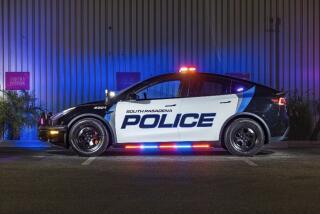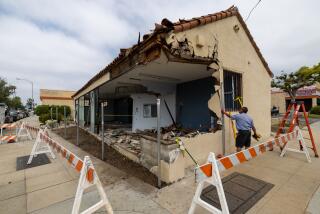Far-Out Class : Pasadena City College Machine Shop Works on 2nd Space Shuttle Job
- Share via
When Pasadena City College instructor Patrick Pandolfi’s machine shop students walked into class last week, they met their newest challenge--building components for yet another space project, a spacecraft propelled solely by the sun’s rays.
Though his students tackle conventional assignments such as making steel hammers, this solar sail spacecraft they will help build seems more like science fiction. From a seven-foot-wide, hat-box-shaped container, the craft’s square sail will expand to half the size of a football field after it is deployed in space in 1990 by a NASA space shuttle.
The $2.2-million project was designed and financed by the South Pasadena-based World Space Center to test long-distance, solar-propelled space travel. It is one of many experiments taking advantage of a NASA program that provides scientists and nonprofit research groups flight time aboard the space shuttles Discovery and Challenger at bargain rates.
And it’s the kind of project that Pandolfi dreams of.
Working on the spacecraft will ignite students’ imaginations and offer challenges they can expect to find on the job, he said. “I like having them work on real projects because they get immediate feedback from professional inspectors and engineers.”
The World Space Center, a nonprofit, international research organization, first sought out the college’s engineering department simply to save money on its solar ship, said spokesman H. W. Price, a Jet Propulsion Laboratory staff engineer.
Later, Price and his colleagues learned of Pandolfi’s success in building an experimental thermodynamic oven to be carried aboard a space shuttle this fall.
Pandolfi, 37, has earned a reputation among his colleagues and the aerospace industry as a first-rate manufacturing engineer passionately devoted to his students.
“He has enhanced the reputation of the department” with such projects, said Lawrence Johannsen, chairman of college’s department of engineering and technology. “Local industries recognize the abilities of his students and hire them.”
“He’s a great teacher,” said student Rich Snyder. “He can just tell if you’re having trouble. He’ll stay late after class explaining and explaining something until you understand it.”
Pandolfi, a native Chilean who came to the college four years ago, said he personally places most of his students from his three classes in machine-shop jobs. “Students don’t fail. Instructors can try to disguise that fact every way they can, but teachers fail.”
His students have just completed the other NASA-related project--a round, 20-inch-high steel oven, which houses 14 computer-operated furnaces. They will be used for conducting experiments in a weightless and non-oxidizing environment while in orbit around the Earth aboard the shuttle. (It too will be part of NASA’s Get Away Special that offers rides aboard shuttles for as little as $5,000, said Clarke Prouty, program manager of NASA’s Small Self-Contained Payload Program.)
The Pasadena City College students accepted the project, building more than 60% of the oven’s parts in about two years, after no other schools were willing to do the work, said Ben Salazar, president of Space Payloads Group, a Pasadena-based nonprofit organization. Its members--scientists, engineers and aerospace consultants--financed and designed the oven.
Salazar and Pandolfi said knowledge gained from the experiments may someday lead to the development of new super alloys, more potent computer microchips and semiconductors and enhanced optics for guided missiles.
Salazar, an executive at Halcyon Microelectronics Inc. in Azusa, said he was thankful for the help of Pandolfi’s students.
By paying only for the oven’s hardware, the Space Payloads Group saved more than $60,000 in wages and machine-shop time, Pandolfi said.
“They did beautiful, excellent work,” said Salazar, crediting Pandolfi for the direction and training he provided his students. “They completed the work in a timely fashion that met NASA and aerospace industry standards.”
In return for the student’s work, Pandolfi said, the college will be able to sell the use of two of the furnaces in the oven to private firms. Rockwell International and IBM are negotiating for their use, he said, and the money--as much as $20,000--will be paid to the college in the form of tax-deductible donations.
Students in James Bowers’ drafting class are completing blueprints for the sail ship while Pandolfi’s machine shop classes begin manufacturing the craft’s machine-made and sheet metal parts. They will continue in summer classes and on into next year.
“We can take on any project that has educational value as long as it is (requested) by a nonprofit organization” that pays for the hardware, said Pandolfi said.
Price of the World Space Center said the sail ship is a continuation of solar propulsion project dropped by Jet Propulsion Laboratory in the 1970s because of funding cutbacks.
Despite the craft’s size in flight, Price said, its sails can be rolled to fit inside its container stowed in the shuttle’s cargo bay. Once ejected from the shuttle, the strong kite-like plastic sails will be deployed by four plastic spars.
Scientists hope the experiment will prove that pressure from the sun’s rays on the sails, which are 20 times thinner than a human hair, will be strong enough to send a spacecraft to be launched in 1990 into a gradually accelerating spiral path away from Earth and into permanent orbit around the sun, Price said. The unmanned ship will be tracked by radar from earth through a battery-operated transmitter aboard the craft.
If the theoretical principles of solar propulsion prove true in space, Price said, future ships may someday be able to reach speeds of 224,000 miles per hour and thus prove to be faster and more efficient than conventional fuel-powered rockets.
More to Read
Inside the business of entertainment
The Wide Shot brings you news, analysis and insights on everything from streaming wars to production — and what it all means for the future.
You may occasionally receive promotional content from the Los Angeles Times.










